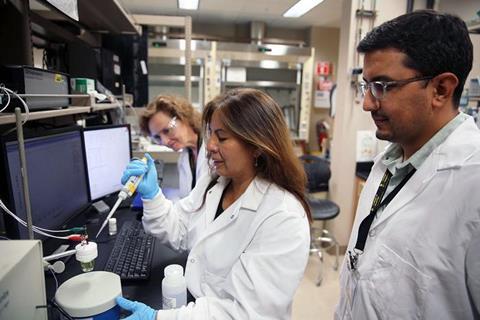For most diseases, early detection leads to better patient outcomes.
That’s why infectious disease experts and chemists at UCF’s College of Medicine and College of Sciences were recently awarded a $537,619 grant from the National Institutes of Health (NIH) to create a low cost, accurate test that detects Hepatitis B, Hepatitis C and HIV at the same time.

The researchers are working to repurpose an existing electrochemical biosensor and apply that technology to quickly identify the viruses at the RNA level and quantify viral loads in resource-limited settings.
READ MORE: Portable HIV monitoring device shows promise for remote settings
READ MORE: Scientists develop low-cost handheld sensor test for airborne bird flu
There is a worldwide need for such a test, as more than 300 million people live with the two forms of hepatitis and more than 40 million live with HIV, World Health Organization data shows. Access to faster and easy-to-use testing can reduce the spread of both viruses and help patients catch hepatitis earlier, reducing their risks of developing liver failure, cirrhosis and liver cancer.
Simultaneous testing also has potential to remove barriers to patient care and help doctors better refine treatment plans.
Shared route of transmission
“It’s very important to detect those viruses in the same sample because those viruses share the same route of transmission and it increases the chance that the same person may get multiple viruses,” said Dr. Yulia Gerasimova, an associate professor of chemistry working on this project. “Doctors need to know how to tailor the treatment for patients depending on if they have a co-infection or not.”
Current diagnostics for both viruses require a blood test and analysis by a clinic or hospital lab. For that reason, testing is difficult in remote and resource-limited areas of the world, where getting results can take months.
During that time, undiagnosed patients get sicker, and the disease may spread.
“I think the goal is to have something that’s accessible worldwide – regardless of the environment,” said College of Medicine researcher Dr. Daniel Ram, an assistant professor of infectious disease who is working on the project. “Having the capacity to detect multiple viruses at once really has potential to benefit everyone.”
Shipping out samples
Dr. Ram recalls growing up in Guyana where his mother was the director of a national clinic that could not process such patient samples on site.
“In order to quantify viruses and patient samples, we would have to ship the samples out to Miami or sometimes Trinidad and Tobago,” he said. “During shipping, those samples degraded and the possibility for failure is high. In the meantime, doctors didn’t know how to best treat the patients.”
The researchers hope to reshape patient care by creating a more accessible and affordable diagnostic that can be used at low resource settings, said Dr. Karin Chumbimuni-Torres, associate professor of chemistry and project lead.
The science behind the tests
Instead of the current blood test that measures the body’s immune response to each virus and the distinct viral load of each virus, the UCF researchers want to repurpose an existing electrochemical biosensor and apply that technology to quickly identify both viruses at the RNA level. They envision that collected samples, such as blood, can be screened with the sensor.
Dr. Chumbimuni-Torres developed similar technology to detect dengue fever and the Zika virus, and her preliminary positive results allowed her to receive the NIH grant for hepatitis and HIV.
The HIV virus often mutates so the UCF scientists programed their sensor to detect any serotype of the disease.
“This is key,” Dr. Chumbimuni-Torres said. “HIV can mutate a lot so we made a technique that can detect any of the mutations.”
Genetic sequences
Because the biosensors conduct genetic testing on the viruses, the scientists can target all the different genetic sequences of both viruses.
“We want to quantify the virus so doctors can know how to treat patients,” Dr. Chumbimuni-Torres said.
Through this research, the team hopes to develop the technology that would work regardless of the source of viral genomes, Dr. Gerasimova said.
“We’re using something called isothermal amplification to amplify viral nucleic acids for them to be detected with virus-specific probes,” she said. “This project is more or less exploratory and we’re developing and fine tuning our technique along the way.”
Viral load
Dr. Ram’s role is to characterize the viruses and determine how to best measure the viral load from a patient’s serum while his collaborators work on the efficacy of the sensor technology.
“We want to be test whether or not the sensors can detect certain amounts of virus and how that would relate to how that may manifest in patients,” he said. “For this round of experimentation, we need to validate with cell cultures and having different quantified amounts of the viruses. Knowing how many viral particles it’s able to detect will allow us to move forward in assessing a patient cohort.”
As the research progresses, Dr. Ram sees the potential for the test to greatly improve the lives of patients worldwide
“This technology has immediate benefit if we can show it to work effectively in detecting multiple viruses,” he said.







No comments yet